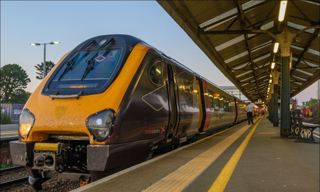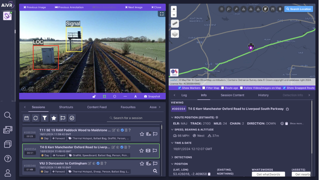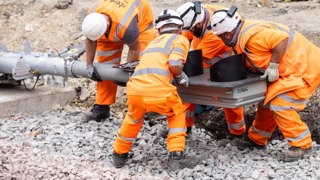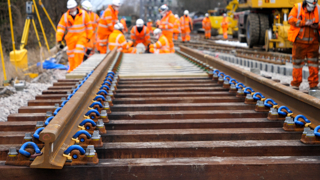Royal Mail is to cease using its dedicated fleet of electric units from October 10 this year, with traffic transferring to road operations.
Rail services have already been scaled back from the time the Railnet postal system was conceived, and for which the Class 325 trains were built in 1995. Only a handful of terminals remain active.
Royal Mail is to cease using its dedicated fleet of electric units from October 10 this year, with traffic transferring to road operations.
Rail services have already been scaled back from the time the Railnet postal system was conceived, and for which the Class 325 trains were built in 1995. Only a handful of terminals remain active.
The decision is a policy change from an earlier announcement that the use of rail services would be increased.
It reflects a loss of competitiveness as a result of the level of the EC4T (Electricity for Traction) tariff levied by Network Rail, which reflects greatly increased supply costs and will total £4.3 billion in the five-year Control Period 7 (2024-29).
Increased traction current costs have resulted in a reversion to diesel freight train haulage on electrified routes. And DB Cargo, which operates the residual Royal Mail services, has withdrawn a fleet of Class 90 electric locomotives. The customer says there are no performance issues that have led to the decision - it is simply of matter of cost comparison with the alternatives available.
Another increased cost component is vehicle maintenance, as the rolling stock has been in service for close to 30 years and there are difficulties with sourcing spare parts.
One of the original 16 units, which are capable of locomotive haulage, was scrapped after an accident in 2021. Spares were retrieved to keep the rest of the fleet in service, although a number of these are now stored out of use. It can be expected that those that remain will be withdrawn and disposed of.
In its announcement that dedicated trains are to cease, Royal Mail said that commercial rail services will continue to be used. This cannot be a reversion to past practice of using brake vans attached to passenger services, as this type of train formation no longer exists. It therefore has to be concluded that intermodal containers will be used, although the terminals and train services that might be suitable are not readily identifiable.
A headline decision of this type raises many questions, as the transfer of long-distance traffic to road haulage (which it is said will require 30 additional drivers and vehicles) is the opposite of government objectives to grow rail freight as part of long-term net zero objectives for the emission of pollutants.
A question for Royal Mail is whether it applied for a Mode Shift Revenue Support grant, which includes provisions to retain traffic on rail, and what feedback it was given about the likelihood of success.
At present, not all requests for funding can be accommodated within the Department for Transport budget, which in recent years has been a little short of £20 million annually.
The effect of the energy supply crisis, as a result of the war in Ukraine, has presented an awkward dilemma. As well as the immediate market response to increased cost of traction current, there is the future impact on business cases for electrification. The cost of installing overhead equipment has previously been justified by a reduction in operating expenses that no longer exists.
Traction current charges that have been published reflect the characteristics of different vehicle types, with locomotives charged at a greater unit price. But it appears that despite lower charges for multiple units, Royal Mail has found the tariff (incorporated with charges from DB Cargo) to be uncompetitive.
It is a far cry from the optimism when the £150m (£315m at current value) Railnet investment project was launched in 1993, when a ten-year contract was signed with British Rail which involved the operation of 70 daily postal trains - including the use of the new units and Travelling Post Offices. The network served more than 50 locations and included the purpose-built Princess Royal Distribution Centre at Willesden, which was designed to handle 34 daily services representing 20% of all mail traffic.
The contract meant that conveying postal traffic was removed from some 300 passenger services. The replacement services provided dedicated overnight transits which operated in three waves for second class mail, first class mail and late evening Travelling Post Offices. The plan included the removal of traditional postal activity at five London terminals, which was transferred to Willesden PRDC.
The change meant that the unique opportunity to post a letter using the sorting van letter box at these stations (for which a minimal supplement was charged) was lost.
Prior to that, the last posting time for specific destinations at many post offices had been brought forward when lineside apparatus where mail was exchanged while the train was in motion ceased to be used in 1971.
A modern-day risk analysis would identify why the practice ceased. A member of the local sorting office would be despatched with a mail pouch to walk along the side of running lines, and often cross them to load the pouch to a spring-loaded arm, which the train would collect using an extended net on the side of the vehicle. Niceties such as a Track Safety Certificate and protective clothing were absent from the process.
The contract represented a significant element of the newly named BR Rail Express Systems sector, which enabled a substantial fleet of Class 47 locomotives to be rebuilt to enhance reliability. And when RES was acquired by the EWS Railway, a further investment in new 125mph Class 67 locomotives was made for use on Railnet services.
It was an unexpected event when the Railnet contract was not renewed in 2003, and the much-celebrated Travelling Post Offices ran for the last time in January 2004. The reasons for this were varied, but concern about staff safety sorting letters in Mk 1 vehicles with poor crashworthiness, and an unwillingness to invest in rolling stock built to higher safety standards, made the decision inevitable.
Later, in 2004, there was to be a return to the use of rail carrying sorted letters between Willesden and Scotland. Other destinations were added, and these have continued until the recent announcement that services are to be withdrawn.
The response from the train operators is to seek intervention about the level of the electric current tariff, which if maintained is going to lead to less electrification and sub-optimal decisions about the type of traction used for freight operations.
Login to continue reading
Or register with RAIL to keep up-to-date with the latest news, insight and opinion.

















Login to comment
Comments
No comments have been made yet.